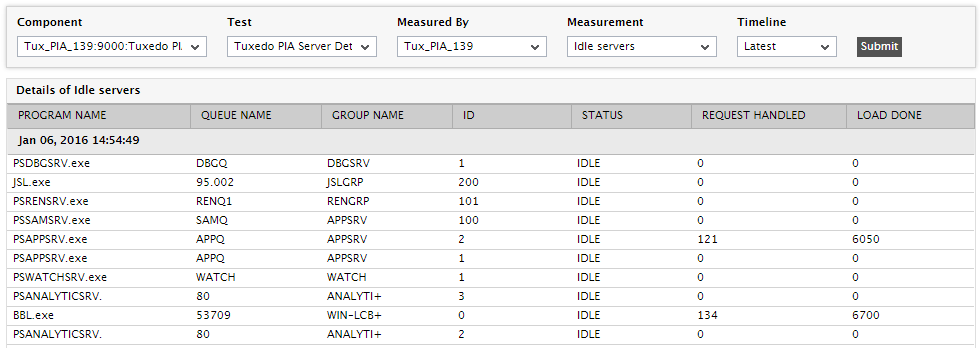Tuxedo PIA Server Details Test
Using this test, administrators can figure out how many server processes in the domain are currently servicing requests, how many are active and ready for requests but have not been assigned requests yet, and the number of server processes that are not even ready for requests. With the help of the detailed diagnosis of this test, administrators can swiftly identify which server process is in which state presently, the number of requests being handled by each server process currently, and the total number of requests per server process for which processing is complete. Using this information, administrators can determine the following:
- Which server processes are idle?
- Which server processes are active, but are not processing any request?
- Which server process is handling too many requests currently?
Target of the test : A Tuxedo Application Server
Agent deploying the test : An internal agent
Outputs of the test : One set of results for the application server domain being monitored.
| Parameter | Description |
|---|---|
|
Test period |
How often should the test be executed |
|
Host |
The host for which the test is to be configured. |
|
Port |
The port number at which the specified Host listens to. By default, this will be 12345. |
|
PSAdmin Home |
To collect metrics from a Tuxedo application server, this test runs PeopleSoft Server Administration (PSADMIN) commands on the target server. The first step towards this is to launch the psadmin.exe. To enable the test to run the psadmin.exe, you need to configure the test with the full path to the directory in which the psadmin.exe resides. Therefore, in the PSAdmin Home text box, specify the location of the psadmin.exe. Typically, this will be the install directory of the Tuxedo application server. For instance, on Windows, your specification can be C:\ps\appsrv and on Unix, your specification can be: opt/ps/appsrv. |
|
Domain |
An application server Domain is the collection of server processes, supporting processes, and resource managers that enable connections to the database. A single application server machine can support multiple application server domains running on it. A server process is executable code that receives incoming transaction requests. The server process carries out a request by making calls to a service. Using a managed Tuxedo application server, you can monitor only those server processes and transactions that pertain to a single domain. This is why, the eG agent needs to be explicitly configured with the application server Domain it needs to monitor. |
|
Detailed Diagnosis |
To make diagnosis more efficient and accurate, the eG Enterprise embeds an optional detailed diagnostic capability. With this capability, the eG agents can be configured to run detailed, more elaborate tests as and when specific problems are detected. To enable the detailed diagnosis capability of this test for a particular server, choose the On option. To disable the capability, click on the Off option. The option to selectively enable/disable the detailed diagnosis capability will be available only if the following conditions are fulfilled:
|
| Measurement | Description | Measurement Unit | Interpretation |
|---|---|---|---|
|
Active servers |
Indicates the number of server processes that are active, but are not processing any request currently. |
Number |
Use the detailed diagnosis of this measure to know which are the active server processes. |
|
Running servers |
Indicates the number of server processes that are actively servicing requests presently. |
Number |
Use the detailed diagnosis of this measure to know which server processes are running currently. |
|
Idle servers |
Indicates the number of server processes that are not even ready for servicing any requests currently. |
Number |
Use the detailed diagnosis of this measure to know which are the idle server processes. |
|
Other servers |
Indicates the number of server processes that are in any other state. |
Number |
Use the detailed diagnosis of this measure to know which server processes are in a state other than Active, Running, or Idle. |
To identify the idle server processes, use the detailed diagnosis of the Idle servers measure.

Figure 1 : The detailed diagnosis of the Idle servers measure of the Tuxedo PIA Server Details test



